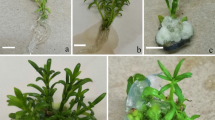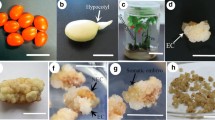Abstract
In vitro studies were initiated with Withania somnifera (L.) Dun. for rapid micropropagation of selected chemotypes using nodes, internodes, hypocotyls and embryo explants. Direct regeneration of shoot buds was observed in MS basal medium supplemented with various concentrations of either benzyladenine (BA) or thidiazouron (TDZ) depending on the explant. Nodal explants formed multiple shoots both from pre-existing and de novo buds on Murashige and Skoog's medium (MS) containing 0.1–5.0 mg l−1 BA and a ring of de novo shoot buds on MS medium containing 0.2 and 0.3 mg l−1 TDZ. Internodal explants formed shoot buds on MS with 1.0 and 5.0 mg l−1 BA while the hypocotyl explants gave rise to multiple shoots only on MS with 0.5 mg l−1 BA. Isolated embryos gave rise to many shoot buds on MS with 0.2 and 0.3 mg l−1 TDZ. The shoot buds elongated and rooted either on MS medium with 0.01 mg l−1 BA or on half strength MS medium lacking growth regulators, which depended upon the growth regulator used in the shoot bud induction medium. Except for the embryo-derived plantlets, all other plantlets could be acclimatized with 100% success.
Similar content being viewed by others
References
Anonymous (1976) Withania. In: The Wealth of India (Raw Materials), Vol. X (pp 580–585). CSIR, New Delhi
Asthana R & Raina MK (1989) Pharmacology of Withania somnifera (L.) Dun. Indian Drugs 26: 199–205
Christianson ML & Warnick DA (1985) Temporal requirement for phytohormone balance in the control of organogenesis in vitro. Dev. Biol. 112: 494–497
Flores HE & Medina-Bolivar F (1995) Root culture and plant natural products: ‘unearthing’ the hidden half of plant metabolism. Plant Tiss. Cult. Biotechnol. 1: 59–74
Glotter E, Kirson I, Abraham A & Lavie D (1973) Constituents of Withania somnifera Dun. XIII. The withanolides of chemotype III. Tetrahedron 29: 1353–1364
Kaul KN (1957) On the origin, distribution and cultivation of Ashwagandha, the so called Withania somnifera Dunal, of Indian literature on materia medica. Pharmaceut. and Drug Committee, Symp. on the Utilization of the Indian Medicinal Plants, Lucknow, 12-14 Oct (pp 7–8)
Kirson I, Glotter E, Lavie D & Abraham A (1971) Constituents of Withania somnifera Dun. XII. The withanolides of an Indian chemotype. J. Chem. Soc. (C): 2032–2044
Kulkarni AA, Thengane SR & Krishnamurthy KV (1996) Direct in vitro regeneration of leaf explants of Withania somnifera (L.) Dun. Plant Science 119: 163–168
Kupchan SM, Doskotch RW, Bollinger P, McPhail AT, Sim GA & Saenz RJA (1965) The isolation and structure elucidation of a novel steroidal tumor inhibitor from Acnistus arborescens. J. Am. Chem. Soc. 87: 5805
Kurup PA (1956) Antibiotic principle of the leaves of Withania somnifera. Curr. Sci. 25: 57–58
Lu C-Y (1993) The use of thidiazouron in tissue culture. In Vitro Cell Dev. Biol. 29P: 92–96
Majumdar DN (1955) Withania somnifera Dunal. Part II: Alkaloidal constituents and their chemical characterization. Ind. J. Pharm. 17: 158–161
Malhotra CL, Das PK, Dhalla NS & Prasad K (1961) Studies on Withania ashwagandha Kaul. Part III: The effect of total alkaloids on the cardiovascular system and respiration. Ind. J. Med. Res. 49: 448–460
Meyer HJ & Van Staden J (1988) In vitro multiplication of Ixia flexuosa. HortSci. 23: 1070–1071
Mok MC, Mok DWS, Armstrong DJ et al. (1987) Biological and biochemical effects of cytokinin active phenylurea derivatives in tissue culture systems. HortSci. 22: 1194–1197
Murashige T & Skoog F (1962) A revised medium for rapid growth and bioassays with tobacco tissue cultures. Physiol. Plant. 15: 473–497
Nigam KB & Kandalkar VS (1995) Ashwagandha In: Chadha KL & Gupta R (eds) Adv. in Hortic. Medicinal and Aromatic Plants. Vol. 11 (pp. 337–344) Malhotra Publishing House, New Delhi
Roja G, Heble MR & Sipahimalani AT (1991) Tissue cultures of Withania somnifera: morphogenesis and withanolide synthesis. Phytotherapy Res. 5: 185–187
Uma Devi P, Sharada AC, Solomon FE & Kamath MS (1992) In vivo growth inhibitory effect of Withania somnifera (Ashwagandha) on a transplantable mouse tumor sarcoma 180. Ind. J. Expt. Biol. 30: 169–172
Uma Devi P, Sharada AC & Solomon FE (1993) Anti-tumor and radiosensitizing effects of Withania somnifera (Ashwagandha) on a transplantable mouse tumor sarcoma 180. Ind. J. Expt. Biol. 31: 607–611
Visser C, Qureshi JA, Gill R & Saxena PK (1992) Morphoregulatory role of thidiazouron. Plant Physiol. 99: 1704–1707
Wardlaw AC (1985) Practical Statistics for Experimental Biologists. John Wiley and Sons, New York
Author information
Authors and Affiliations
Corresponding author
Rights and permissions
About this article
Cite this article
Kulkarni, A.A., Thengane, S. & Krishnamurthy, K. Direct shoot regeneration from node, internode, hypocotyl and embryo explants of Withania somnifera . Plant Cell, Tissue and Organ Culture 62, 203–209 (2000). https://doi.org/10.1023/A:1006413523677
Issue Date:
DOI: https://doi.org/10.1023/A:1006413523677




